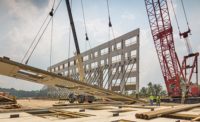Most of us are familiar with what is known as “tilt-up” construction. This type of construction is evident by the name. In simple terms, concrete wall panels are formed on the ground or on the building’s concrete floor slab, allowed to set and then tilted up. The end result is a fast and cost-effective means of wall construction. This process is not to be confused with pre-fabrication.
The first tilt-up walls were done on simple warehouses. This is where insulation and finishes did not really matter. Tilt-up has come a long way since those early days. There are benefits and drawbacks to this type of construction. The benefits are mainly two: cost and speed. Lower cost and faster construction are no-brainers, as tilt-ups have taken full advantage of the continued trend of cost overruns and scheduling delays.
Where is Tilt-up Construction Used?
Tilt-up is popular in all of North America, Australia, New Zealand and gaining popularity in Africa, the Middle East and southern Asia. Tilt-up is not often used in Europe and northern Asia. Why does Europe not use tilt-up? Concrete and cement are both extremely popular in Europe. I believe there are two reasons the European market does not use tilt-up construction. The first is the abundance of masonry workers in Europe. Most buildings are constructed with structural masonry units and there is no real shortage of productive masons. A concrete masonry unit wall can be done fast and at a low cost if you have crews that are trained to be fast. The cost savings for concrete tilt-up are just not realized. The second reason is how Europeans insulate walls. Most of Europe uses an EIF system. EIFS and masonry wall substrates are perfect for each other. Using EIFS on the outside allows the inside to avoid the framing or furring used to encase wall insulation. The interior side of the CMU wall is just skim coated with plaster.
Tilt-up construction has morphed and adapted to suit more building types and styles than just warehouses. They are used on all kinds of structures today. Tilt-up panel walls are very heavy and rely on connections. Connections to each other (i.e., roof framing and floor framing). Due to the weight and inflexibility of the wall, a significant seismic event can tear connections apart. This is catastrophic if the heavy panels come down in one piece on building occupants.
Fortunately, codes and engineers address this issue. Code-compliant connections are even approved for earthquake-prone regions. It is generally agreed that tilt-ups constructed before 1996 should be reviewed by engineers and will likely benefit from seismic retrofits. This will typically include retrofitting roof to wall anchors and adding continuity ties.
Making Tilt-up Construction Sustainable
Another benefit of tilt-up is a smaller carbon footprint. Tilt-up construction, in its simplest form, requires only forms for concrete that may even be re-used. Tilt-ups generally have less waste when compared to more traditional methods of construction. Concrete is a concern for environmentalists. However, most concrete and cement producers have made significant strides in reducing water waste and conserving energy use in the manufacturing of cement clinker. Sustainability should be the goal.
For a product to be considered sustainable, it should meet the three prime pillars (or P’s) of sustainability: People, planet and profit. The first two are simple. The product must be good for people and do no harm, and the same is for the planet. The final P is profit and this is not related to a contractor making a profit on the job. It is when the product is proven to last and—in turn—is profitable to the building owner. A product can be green but not sustainable. A sustainable product must be green. If a material has a short lifespan, there is no sustainability for the planet, people or the building owner’s wallet. It would be hard to find a product more durable and proven to last than cement and concrete.
The outside face of the concrete tilt-up was typically patched and painted in the past. Today, patterns can be placed using forms prior to pouring concrete. Thin brick can be set in forms face-down before the concrete pour. As the concrete wall is lifted or tilted up, the brick has been fused with the concrete wall. EIFS can also be applied to properly prepared concrete tilt-up walls. Cement stucco, while the same basic material as concrete, is generally not recommended over concrete tilt-up walls due to the weight of stucco and the smooth face of the tilt-up panels. In addition, EIFS can provide the same appearance as stucco with minimal weight and can even add insulation value. Tilt-ups are not going away; there are just too many benefits and more options than ever before.





Report Abusive Comment